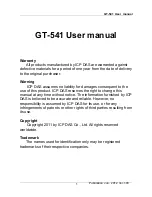
7/21/2020
TTU-2900 Hardware & Installation Guide - PULS Wiki
5/29
materials are grounded, workers are grounded, and charge build-up on ESD sensitive electronics is prevented. International standards are used to
define typical EPA and can be obtained for example from International Electro-technical Commission (IEC) or American National Standards
Institute (ANSI).
This ESD classification of the sub assembly will be defined for the most sensitive component, therefore the following classifications apply:
Class 1B – Human Model (< 1 kV)
Class M1 – Machine Model (< 100V)
When handling the TTU-2900
™
’s
™
main-board (i.e. sub assembly) by itself or in a partial housing proper ESD precautions should be taken. The
handler should be in an ESD safe area and be properly grounded.
GPS Ceramic Patch Handling
When handling the sub assembly it may be natural to pick it up by sides and make contact with the antenna boards. In an uncontrolled ESD
environment contact with the center pin of ceramic patch antenna can create a path for electrostatic discharge directly to the GPS Module. The
GPS Module is very sensitive to ESD and can be damaged and rendered non-functional at low levels of ESD.
One should avoid contact with the center pin of the patch during handling.
Packaging
Anytime the sub assembly is shipped and it is not fully packaged in its final housing it must be sealed in an ESD safe bag.
Electrical Over-Stress (EOS)
The GPS receiver can be damaged if exposed to an RF level that exceeds its maximum input rating. Such exposure can happen if a nearby source
transmits an RF signal at sufficiently high level to cause damage.
Storage and Shipping
One potential source of EOS is proximity of one TTU-2900
™
GPS Antenna to another TTU-2900
™
GSM Antenna. Should one of the units be in
a transmit mode the potential exists for the other unit to become damaged. Therefore any TTU-2900
™
GPS Antenna should be kept at least four
inches apart from any active TTU-2900
™
GSM Antenna or any other active high power RF transmitter with power greater than 1 Watt.
3.1.2
Battery Back-up devices
Please properly dispose of the battery in any of the CalAmp products that utilize one, do not just throw used batteries, replaced batteries, or units
containing a back-up battery into the trash. Consult your local waste management facility for proper disposal instructions.
3.1.3
Environmental Specifications
The TTU-2900
™
is designed to operate in environments typically encountered by heavy and light duty fleet vehicles, including wide temperature
extremes, voltage transients, and potential interference from other vehicle equipment.
To ensure proper operation in such an environment, TTU-2900
™
s were subjected to standard tests defined by the Society of Automotive
Engineers (SAE). The specific tests included temperature, shock, vibration, and EMI/EMC. These tests were performed by independent labs and
documented in a detailed test report.
The following shows the environmental conditions the TTU-2900
™
is designed to operate in and the relevant SAE tests that were performed. No
formal altitude tests were conducted.
Temperature
Operating Temperature Range: -30
o
C to 75
o
C
Storage Temperature Range: -40
o
C to 80
o
C
SAE Test: SAE J1455
Humidity
95% relative humidity, 50° non-condensing
SAE Test: SAE J1455
Altitude
Operates at altitudes of up to 10,000 feet and can be stored safely up to 40,000 feet






































